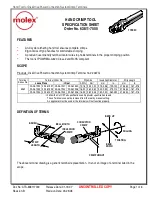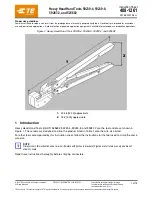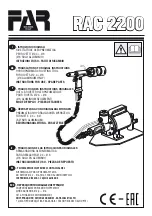
5.
Do not throw battery packs into an open
fire. There is a risk of explosion!
6.
Do not ignite the battery pack or expose
it to fire.
7.
Do not exhaustively discharge batteries.
Exhaustive discharge will damage the
battery cells. The most common cause of
exhaustive discharge is lengthy storage
or non-use of partly discharged batteries.
Stop working as soon as the performance
of the battery falls noticeably or the elec
-
tronic protection system triggers. Place
the battery pack in storage only after it
has been fully charged.
8.
Protect batteries and the tool from
overloads. Overloads will quickly result in
overheating and cell damage inside the
battery housing without this overheating
actually being apparent externally.
9.
Avoid damage and shocks. Replace
batteries which have been dropped from
a height of more than one meter or which
have been exposed to violent shocks
without delay, even if the housing of the
battery pack appears to be undamaged.
The battery cells inside the battery may
have suffered serious damage. In this
respect, please also read the waste dis-
posal information.
10.
If the battery pack suffers overloading
and overheating, the integrated protective
cut-off will switch off the equipment for sa
-
fety reasons. Important. Do not press the
ON/OFF switch any more if the protective
cut-off has actuated. This may damage
the battery pack.
11.
Use only original battery packs. The use
of other batteries may result in injuries,
explosion and a fire risk.
Information on chargers and the charging
process
1.
Please check the data marked on the ra
-
ting plate of the battery charger. Be sure
to connect the battery charger to a power
supply with the voltage marked on the
rating plate. Never connect it to a different
mains voltage.
2.
Protect the battery charger and its cable
from damage and sharp edges. Have
damaged cables repaired without delay
by a qualified electrician.
3.
Keep the battery charger, batteries and
the cordless tool out of children’s reach.
4.
Do not use damaged battery chargers.
5.
Do not use the supplied battery charger
to charge other cordless tools.
6.
In heavy use the battery pack will become
warm. Allow the battery pack to cool to
room temperature before commencing
with the charging.
7.
Do not over-charge batteries. Do not ex
-
ceed the maximum charging times. These
charging times only apply to discharged
batteries. Frequent insertion of a charged
or partly charged battery pack will result
in overcharging and cell damage. Do not
leave batteries in the charger for days on
end.
8.
Never use or charge batteries if you sus
-
pect that the last time they were charged
was more than 12 months previously.
There is a high probability that the battery
pack has already suffered dangerous
damage (exhaustive discharge).
9.
Charging batteries at a temperature
below 10°C will cause chemical damage
to the cell and may cause a fire.
10. Do not use batteries which have heated
during the charging process, as the bat-
tery cells may have suffered dangerous
damage.
11. Do not use batteries which have suffe-
red curvature or deformation during the
charging process or which show other
non-typical symptoms (gassing, hissing,
cracking,…)
12.
Never fully discharge the battery pack
(recommended depth of discharge max.
80%) A complete discharge of the battery
pack will lead to premature ageing of the
battery cells.
13. Never charge the batteries unsupervised.
Protection from environmental influences
1.
Wear suitable work clothes. Wear safety
goggles.
2.
Protect your cordless tool and the battery
charger from moisture and rain. Mois
-
ture and rain can cause dangerous cell
damage.
3.
Do not use the cordless tool or the battery
charger near vapors and inflammable
liquids.
4.
Use the battery charger and cordless
tools only in dry conditions and an ambi
-
ent temperature of 10- 40°C.
5.
Do not keep the battery charger in places
where the temperature is liable to reach
over 40°C. In particular, do not leave the
battery charger in a car that is parked in
the sunshine.
6.
Protect batteries from overheating. Over
-
loads, over-charging and exposure to di
-
rect sunlight will result in overheating and
cell damage. Never charge or work with
batteries which have been overheated –
replace them immediately if possible.
7.
Storage of batteries, battery chargers
and cordless tools. Store the charger
and your cordless tool only in dry places
with an ambient temperature of 10-40°C.
Store your lithium-ion battery pack in a
cool, dry place at a temperature of 10-
20°C. Protect them from humidity and
direct sunlight. Only place fully charged
batteries in storage (charged at least
40%).
8.
Prevent the lithium-ion battery pack from
freezing. Battery packs which were stored
below 0°C for more than 60 minutes must
be disposed of.
9. When handling batteries beware of elec-
trostatic charge: Electrostatic discharges
cause damage of the electronic protec
-
tion system and the battery cells. Avoid
electrostatic charging and never touch the
battery poles.
Additional safety instructions
•
This tool may only be used for dry grin
-
ding/sanding operations.
•
Always guide the power cable away from
the back of the tool.
•
Use of the tool on materials containing
asbestos is prohibited.
•
Always remove the plug from the power
supply socket before carrying out any
work on the machine (cleaning the san
-
der, changing the sandpaper, etc.).
•
Always disconnect the machine by
removing the plug from the socket, not by
pulling on the power cable.
•
To protect your health, always wear
safety goggles and a dust mask during
sanding work.
•
Keep your workplace clean and well
illuminated.
•
Make sure that the workpiece is suffici
-
ently secured so that it cannot slip.
•
Keep children away.
•
For your own sake, keep the machine
clean at all times and check it for signs of
damage each time after using it.
•
Make sure that the switch is set to OFF
before you insert the plug into the power
supply socket.
•
Make sure of your footing, particularly
when working on ladders and platforms.
•
Touching or inhaling this dust can be
harmful for the operator and other per
-
sons nearby.
•
Important! Wear safety goggles and a
dust mask.
Intended Use
m
The multifunction tool is suitable for sanding/
grinding small areas. A sanding/grinding tool
with a vacuum extractor must be used for
sanding/grinding large areas.
The equipment is designed for the sanding/
grinding of wood, iron, plastic and similar ma
-
terials using the appropriate sanding/grinding
paper. Furthermore, the equipment is intended
for sawing wood, plastic and similar materials,
as well as scraping off glued carpets, filling
compound residues, old paint and similar
applications.
The equipment may only be used for the tasks
it is designed to handle. Any other use is
deemed to be a case of misuse. The user/ope
-
rator and not the manufacturer will be liable for
any damage or injuries of any kind caused as
a result of this.
Please note that our equipment has not been
designed for use in commercial, trade or
industrial applications. Our warranty will be
voided if the equipment is used in commercial,
trade or industrial businesses or for equivalent
purposes.
GB
12
Summary of Contents for 5909204900
Page 2: ...2 ...
Page 3: ...Fig 1 1 2 3 5 4 3 ...













































